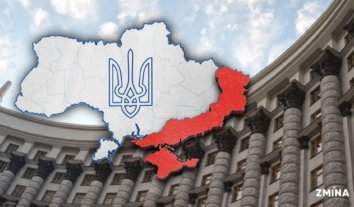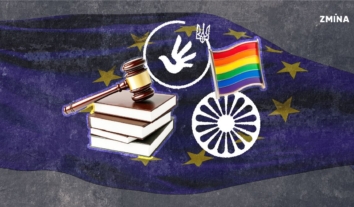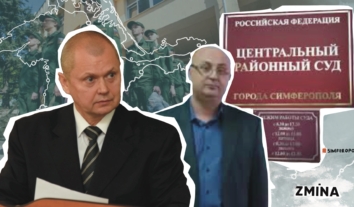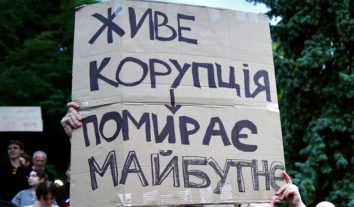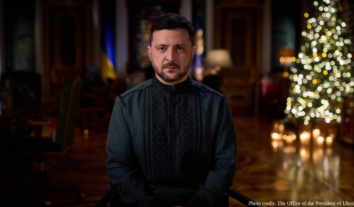Who works in the courts of first instance in the occupied part of Donetsk region
Last year, the Russians were concerned with bringing the justice system of the so-called “Donetsk People’s Republic” (DPR) to the federal level.
Earlier, ZMINA told you how the local “Donetsk” servants of Themis were suddenly pushed out of their seats in the “DPR Supreme Court” by the disgraced head of the “Moscow cassation” Nikolai Podkopaev. We also wrote about who became judges in the occupied Kherson and Zaporizhzhia regions. Read about the work of the occupation courts in the Donetsk region in this article.
No reboot required
The Donetsk occupation system of “justice” developed in 2014 is based on Ukrainian traitor judges, who have been the backbone of the judiciary of the illegal DPR formation all this time. Many have been working without a break for the second decade and have already taken their third oath of allegiance. There are even family clans of Donetsk judges, such as Svitlana and Grigory Fedko from Horlivka.
Almost every year, the composition of judges was replenished with new people willing to serve the Themis of the so-called “young republic.” Since the process was led for a long time by Eduard Yakubovsky, a former employee of the Russian Investigative Committee, as the head of the “Supreme Court of the DPR,” most of the positions were filled by people from among Donetsk collaborators working in the investigative bodies. For example, Natalia Ryadno, the head of the investigative department of the Kalininsky District Police Department in Horlivka, betrayed her oath and remained working for the “DPR.” She became a judge and headed the Central City District Court in 2016.
It is noteworthy that after Yakubovsky, the head of the “Supreme Court of the DPR” was Andrey Kim, a member of the Russian Investigative Committee, who served in Kislovodsk before joining the process of establishing “justice” in the occupied territory of Donbas. It is unknown whether he preferred former investigators when appointing judges, but generally, the “police” clan is widely represented in the courts of the “DPR.”
All the courts launched in the occupied territory in 2014, during the “pre-Russian period,” have retained their entire judiciary virtually unchanged after being transferred to “federal standards.” For example, the head of the court, Olena Skichko, has been heading the Yasynuvata City Court since 2014.
To court on a tank?
Of the 133 “DPR judges” identified in the courts of general jurisdiction, only 29 are currently from Russian regions.
Many were appointed to “courts” established in the territories occupied after the outbreak of full-scale war or even to courts in regions generally under Ukrainian control. For example, the only currently known judge of the Volnovakha District Court, Rafik Mukhametshin, was previously an assistant judge in one of the districts of Orenburg, Russia.
Angelina Demidova, a judge of the Artemivsk City Court on the ruins of Bakhmut, previously worked as an assistant judge in the Lazarevsky district of Sochi, Krasnodar Territory. Her colleague Rinat Mudarisov also worked as an assistant judge in the Blagovarsky district of Bashkortostan.
Even more interestingly, the Kramatorsk City Court, which exists only formally, appointed Aeromaa Kochneva, a former judge of the Dzun-Khemchitsky District Court of the Republic of Tyva, as its chairman. Moreover, according to the Russian state system “Pravosuddie,” the Kramatorsk court is located at the address of the Leninsky District Court of Donetsk.
In all of these cases, the apparent career advancement of the newly qualified ministers of the Donbas Themis attracts attention. Aeromaa Kochneva went from being an ordinary judge to the head of a court, even if it was fictitious. All the rest of them jumped over the mandatory position of a magistrate judge in Russian realities and immediately received mantles in courts of general jurisdiction. For some reason, no Russian judges were willing to change their offices to work in frontline conditions.
The Mariupol landing force
However, the lion’s share of Russians went to form judicial bodies in occupied Mariupol. For example, out of the seven appointed “judges of the Primorsky District Court,” only Victoria Grevtsova was previously a “judge of the DPR,” and Vladimir Reznichenko changed his status as a Ukrainian lawyer and the dean of the Faculty of Law of the Interregional Academy of Personnel Management to a Russian judicial mantle. The other five are from Rostov Region, Krasnodar Territory, Perm, and Orenburg. Moreover, Victoria Boyko and Botagoz Tleuzhanova made a career leap, turning from assistants to full-fledged judges at the same time.
Of the six “judges of the Illichivsk District Court,” half are from Saratov Oblast. The same region where the “head of the Supreme Court of the DPR,” Nikolai Podkopaev, headed the cassation instance before his disgrace. Moreover, the “judges” Ekaterina Stepanova and Marina Zemtsova used to be ordinary assistant judges in the same cassation court headed by Podkopaev.
“Judge” Valeriy Belavkin, who previously worked as a lawyer in Anapa, also made an incredible career rise in the occupied territory. The local collaborators on the court also have no work experience – no information could be found about Irina Pankratova, and Natalia Dorosh worked as an assistant in a Ukrainian court before the occupation.
The highest number of new judges was in the Ordzhonikidze and Oktyabrsky district courts of Mariupol. For example, in Ordzhonikidze court, Elvira Guzairova, a former judge of Belokatay inter-district court of Bashkortostan, and her fellow countrywoman, Renata Sakhapova, a magistrate from Ufa, were appointed as deputy judges. They were accompanied by former justices of the peace Denis Pavlenko from the Krasnodar Territory and Aindi Alimkhanov from Chechnya. Only Yevheniya Havryliuk, an assistant in this court before the occupation, represents local collaborators.
Former magistrate judge Dmitry Romanov from Tver, his colleague Natalia Kralinina from Krasnodar Territory, and former Krasnodar lawyer Roman Plyushkin moved to work in the Oktyabrsky Court from Russia. A certain Yulia Sazonova, who used to be the judge’s secretary, sits in their company.
Notably, the village of Mangush, located very close to Mariupol, has not yet seen a single visiting judge. The only “judge” appointed by the Russian authorities to the “Pershotravnevy District Court” is Inna Popova, who was reported in a Mariupol chat room to have been an assistant judge in the Oktyabrsky Court and then sewed clothes and accessories for children.
Ghost courts
The overall picture of the “DPR judicial system” transformed to Russian standards would be incomplete without mentioning the 16 phantom courts.
In addition to the aforementioned “Kramatorsk City Court” [Kramatorsk is under Ukrainian control], these include Konstantinovka, Sloviansk, Avdiivka, Maryinka, Vuhledar, Krasnolimansky, as well as “courts” around Pokrovsk, Selidove and Velyka Novosilka. There is no publicly available information about the appointment of judges to these courts, and their addresses in the Russian system, “Pravosuddie,” are listed at the location of other judicial bodies in the occupied territory.
The occupation authorities have organized a total of 39 “courts” of the first instance within the illegal entity “Donetsk People’s Republic,” of which 40% are located either near the front line or on the territory controlled by Ukrainian forces.

